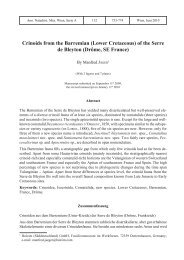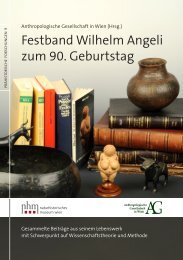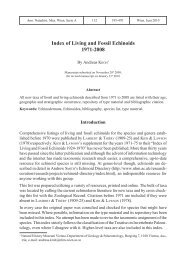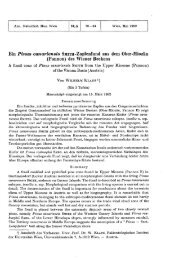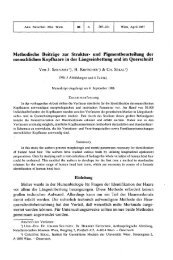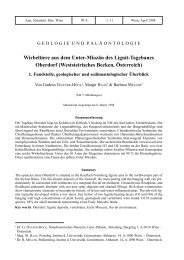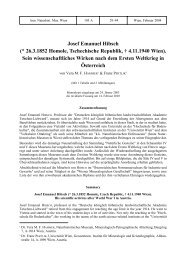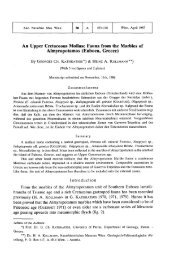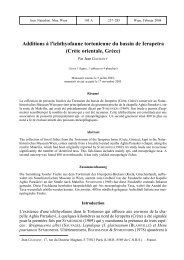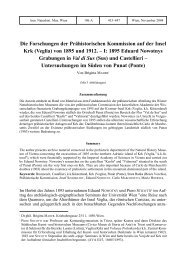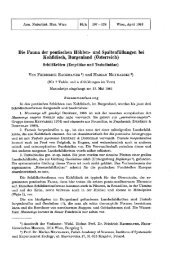Gastropods from the Lower Cretaceous of Vorarlberg, Austria. A ...
Gastropods from the Lower Cretaceous of Vorarlberg, Austria. A ...
Gastropods from the Lower Cretaceous of Vorarlberg, Austria. A ...
Create successful ePaper yourself
Turn your PDF publications into a flip-book with our unique Google optimized e-Paper software.
32 Annalen des Naturhistorischen Museums in Wien 103 A<br />
Pyrgotrochus cf. lemani (LORIOL)<br />
Plate 2, Figures 14 - 16<br />
? 1861 Pleurotomaria Lemani LORIOL, p. 3, pl. 3, fig. 9<br />
? 1863 Pleurotomaria Lemani LORIOL - PICTET & CAMPICHE, p. 421<br />
? 1879 Pleurotomaria Lemani LORIOL - VACEK, p. 740<br />
1879 Pleurotomaria Favrina LORIOL - VACEK, p. 741<br />
? 1933 Pleurotomaria Lemani LORIOL - HEIM, BAUMBERGER & FUSSENEGGER, p. 204<br />
Material: Reference material <strong>of</strong> VACEK, 1879, <strong>from</strong> <strong>the</strong> Breiterberg, close to Bad Haslach<br />
(one small internal mould (GBA 1879/01/75) and one large specimen with <strong>the</strong> shell<br />
preserved (GBA 1879/01/78); reference material <strong>of</strong> HEIM, BAUMBERGER & FUSSEN-<br />
EGGER, which is a doubtful internal mould (VN: P10371)<br />
Dimensions. GBA 1879/01/78: H: 42 (est.: 46); B: 41.5; LW: 22.2; A: 50. Internal<br />
mould, P 10371: H: 46; B: 43; A: 35°<br />
Description. Shell high conical, whorls slightly concave, with numerous smooth spiral<br />
ribs. Selenizone at mid-whorl, with rounded top. Periphery <strong>of</strong> last whorl acute. External<br />
half <strong>of</strong> base flat, internal half moderately concave, with sculpture <strong>of</strong> spiral threads.<br />
Remarks. Both <strong>the</strong> internal mould and <strong>the</strong> shell are high spired and possess moderately<br />
concave whorls. The characteristic change <strong>of</strong> <strong>the</strong> base <strong>from</strong> convex to concave is reproduced<br />
on <strong>the</strong> adapical end <strong>of</strong> <strong>the</strong> mould. These characters and <strong>the</strong> traces <strong>of</strong> spiral threads<br />
on <strong>the</strong> whorl face mentioned by PICTET & CAMPICHE, 1863, lit. cit., allow keeping <strong>the</strong><br />
determination by HEIM, BAUMBERGER & FUSSENEGGER, 1933, with some reservation.<br />
Distribution. Mont Salève, Haute Savoie, France<br />
Distribution in <strong>Vorarlberg</strong>. According to HEIM, BAUMBERGER & FUSSENEGGER, 1933, <strong>the</strong><br />
specimens were collected in a block <strong>of</strong> debris originating <strong>from</strong> <strong>the</strong> base <strong>of</strong> <strong>the</strong><br />
Kieselkalk Formation. Their biostrigraphic position may be deeper in <strong>the</strong> section than P.<br />
concavus n. sp.<br />
Pleurotomariidae <strong>of</strong> unknown systematic position<br />
Pleurotomariidae, indet. 1<br />
Plate 2, Figure 17<br />
1933 Pleurotomaria bourgeti HEIM, BAUMBERGER & FUSSENEGGER, p. 205<br />
Material. Reference material to HEIM, BAUMBERGER & FUSSENEGGER, 1933: 1 internal<br />
mould, Breiterberg, close to Bad Haslach (VN: P 10375)<br />
Dimensions. H: 28; B: 33.2; LW: 13.7; A: 110°<br />
Description. Large, low conical mould. Whorls low, whorl face convex. Periphery <strong>of</strong><br />
last whorl angular. Base slightly convex, ?broad umbilicate. Impressions <strong>of</strong> sculpture in<br />
<strong>the</strong> umbilicus show noded spiral ribs and growth lines.<br />
Remarks. The selenizone is not preserved but <strong>the</strong> impression <strong>of</strong> <strong>the</strong> sculpture is that <strong>of</strong><br />
a pleurotomariid. Pleurotomaria bourgeti AGASSIZ is a manuscript name. It was applied



